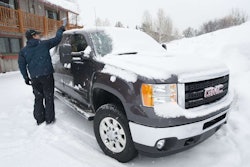Tips to keep your pickups in tip-top shape
By Steve Temple
 SUSPENSION STABILITY
SUSPENSION STABILITY
The factory suspension on a pickup might not be stout enough to handle some of your more severe-duty jobs. Heavy loads which make your truck’s rear end sag several inches can cause handling problems (along with pointing your headlights up in the air).
Also, changing the center of gravity, such as with a large stack of material on a roof rack, creates excessive body roll, which can even occur with utility-bed trucks, especially once they’re several years old and the suspension has taken a beating.
For a few hands-on tips about evening out your suspension, we spoke with David Wheeler, engineer for Hellwig Products, which has been making helper springs since 1945.
The company also offers sway bars and air bags for a wide range of vehicles. The majority of its products go on pickups, for both consumers and tradesmen.
Before adding anything, Wheeler’s first recommendation is to check the U-bolts on your spring packs.
“Losing clamp load is the number one cause of spring failure,” he points out. “You should regularly check and re-torque your bolts.”
If snugging down your factory leaf springs doesn’t work, you can level out the load of your pickup by either adding helper springs or an air bag system like we’ve done on our Big Red Sweepstakes project dually.
“But not both,” Wheeler points out, because you shouldn’t ever exceed your pickups GVWR (Gross Vehicle Weight Rating). Each system has their advantages: “Helper springs are no-maintenance – just set ‘em and forget ‘em. Air bags have adjustability.”
On the latter, he says it’s important to keep the air-fill system separate for each bag (rather than using a T-fitting to join them together). Otherwise the air will flow from one bag to the other as the vehicle leans, making body roll worse.
Another tech tip is to keep the bags or springs far apart from each other.
“The effect of distance between springs is actually squared,” he explains. “So mount them as far outboard as possible. The wider the springs, the more roll stiffness.”
Thicker aftermarket sway bars can also reduce body lean (without affecting ride quality), especially if your pickup is lifted and is being tasked to haul heavy loads or tow big equipment trailers.
Hellwig offers sway bars for those types of applications.
FYI on EGT
 If you don’t have an EGT (Exhaust Gas Temperature) gauge in your diesel pickup, get one. And if you already do, make sure you keep an eye on it, especially when handling heavy loads on steep climbs.
If you don’t have an EGT (Exhaust Gas Temperature) gauge in your diesel pickup, get one. And if you already do, make sure you keep an eye on it, especially when handling heavy loads on steep climbs.
An EGT gauge reacts more quickly than the water temperature gauge, so it allows you to spot an overheat problem sooner and avoid engine damage.
If the EGT climbs above 1,250 degrees F for even a short period of time, say, several seconds, you can cook your turbo, melting the square corners at the outer ends of the vanes where the material is thinnest on the turbine wheel.
After the tips melt, the turbine wheel becomes imbalanced, wearing down the turbocharger bearings, which can also waste the shaft and eliminate both the turbine and compressor wheels. Those are very costly to replace in both parts and labor.
 Reducing a high EGT is a simple matter: either back off the throttle or downshift, which increases engine revs and thus the boost level.
Reducing a high EGT is a simple matter: either back off the throttle or downshift, which increases engine revs and thus the boost level.
More boost (hopefully you have a gauge for that as well) pushes out more heat, thus lowering the EGT.
Placement of the pyrometer (aka thermocouple), the temperature sensor for the EGT gauge on your dash, is important as well.
Typically the pyrometer’s sensing probe is mounted in the exhaust manifold or immediately after the turbine outlet of the turbocharger. Placing the probe a few inches away from those ideal locations can result in markedly different readouts.
If the EGT is measured after the turbine, the turbine outlet temperature at full throttle or under a heavy load typically can be 200 to 300 degrees F lower than when measured in the exhaust manifold. This temperature drop results from the heat energy expended to drive the turbocharger.
In addition, this drop depends on the flow through the turbo.
At part throttle, under light load, such as at cruise conditions, the turbine outlet EGT may be as much as 500 degrees F. lower than the turbine inlet temperature. Also, at high turbine speeds (under heavy load), the exhaust gases don’t give up as much heat energy as they speed through the turbine.
This variance is why BD Power (bdpower.com) recommends installing a thermocouple in the exhaust manifold, where the measurement is more accurate.
EGT gauges come in a wide variety of types and sizes. We have separate AEM gauges in Big Red to monitor EGT, boost and water-meth flow.
The one on my work truck consists of a pair of needles combined in a single housing to display both EGT and boost so I can compare them at glance and estimate the most economical throttle setting.
Thin is In
You’ve probably often heard oil is the lifeblood of an engine. If that’s the case, what can you do to purify it, so to speak?
 Turns out thin is in, according to Shell Rotella, who notes a number of diesel engine manufacturers now recommend lower viscosity lubricants in their newest engines.
Turns out thin is in, according to Shell Rotella, who notes a number of diesel engine manufacturers now recommend lower viscosity lubricants in their newest engines.
The reasons to consider switching from thicker, conventional petroleum lubricants to lower viscosity, full synthetic or synthetic-blend motor oils are many.
Fuel economy is one, Shell says, since synthetic SAE 5W-40 oil offers less resistance to rotating engine components than conventional SAE 15W-40.
When internal friction is reduced, less energy is consumed during cold starts as well.
Mobil makes similar comments about improved fuel efficiency for its Delvac Synthetic Lubricants.
When used in combination with the company’s gear oils and transmission fluids, the company has data demonstrating an improvement of as much three percent over conventional mineral lubricants.
(We run Mobil Delvac’s synthetics in Big Red and I’m in the process of doing some before-and-after fuel economy testing to verify this claim on my own pickup.)
Other advantages of low-viscosity synthetics include extended-drain capability, enhanced engine cleanliness and better wear protection.
INJECTOR TIP
The straw that broke the camel’s back is a good way to sum up a faulty injector. It’s only a small component, but it can make or break your diesel pickup.
For those with common-rail fuel injection, we came across a few warning signs to cripple your beast of burden.
On mid-2003 and later Cummins, when excessive exhaust smoke is present and the engine revs run-on or even race, odds are good the injectors are stuck open, dumping gobs of fuel into the cylinders.
 Larry Collins of Collins Diesel Injection (209/948-4410), a 40-year veteran diesel mechanic in Stockton, California, cures such ills using for Bosch re-manufactured units over Dodge injectors, based on first-hand experience and some additional tech input.
Larry Collins of Collins Diesel Injection (209/948-4410), a 40-year veteran diesel mechanic in Stockton, California, cures such ills using for Bosch re-manufactured units over Dodge injectors, based on first-hand experience and some additional tech input.
He also points out since Bosch developed the units, it knows them better than anybody and has sophisticated testing equipment to ensure reliable operation.
For ’02-and-newer Duramax owners, while the injector has the same basic design, sticking open is not an issue – leaking is the problem.
Collins says such leakage results in dilution of crankcase oil. Simply checking the oil level to see if it’s been rising is cause for getting an oil test done.
As for Fords, he’s run into a lot of lubricity issues with the 6.0L and notes there’s even a new word to sum it up: “stiction,” referring to an injector which stays open or closed. Sometimes the injector is either lazy coming off the seat or won’t seat properly, so the pulse width is far too big.
Collins has a wealth of experience with injectors, knows several quick fixes and is willing to share them if you suspect a problem with your diesel pickup.








